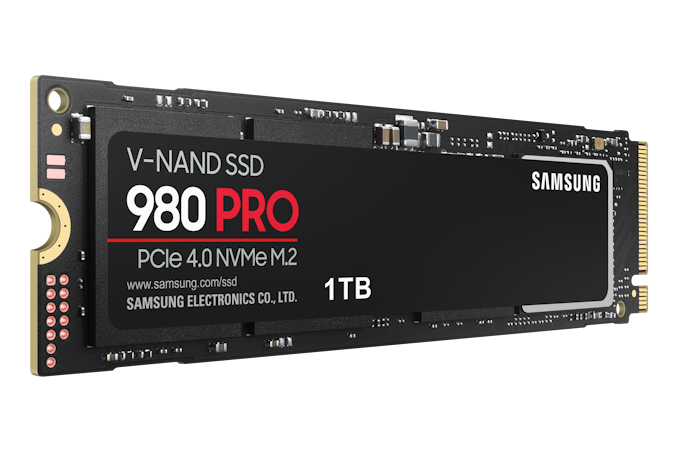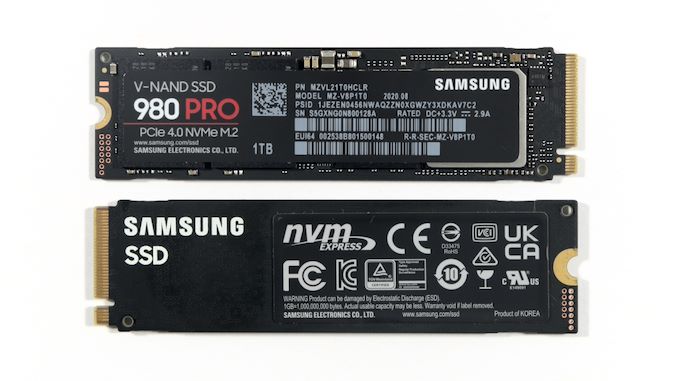The Samsung 980 PRO PCIe 4.0 SSD Review: A Spirit of Hope
by Billy Tallis on September 22, 2020 11:20 AM ESTSamsung 980 Pro: Top Shelf, No Drama
With the release this month of the Samsung 980 PRO, a new round of competition in the high-end SSD market is beginning. The 980 PRO boasts higher performance than any other consumer SSD currently available, including sequential reads at 7GB/s and random reads at up to a million IOs per second. Samsung is continuing their habit of retaking the SSD performance crown, and almost making it look easy. At the same time, the 980 PRO will be priced a bit more reasonably than previous Samsung PRO models thanks to the switch to more affordable TLC NAND. But focusing only on the raw performance capabilities of the 980 PRO can distract from its true purpose, and the real impact of the 980 PRO won't be as dramatic as those top line performance numbers would suggest.
The fundamental problem facing the 980 PRO and other high-end NVMe drives is that the rest of the system can't keep up. Very few real-world consumer workloads can keep this SSD busy enough to make good use of its full performance potential. Hitting 5-7GB/s or 1M IOPS certainly sounds impressive, but that's only possible in fairly unrealistic conditions. The high sequential transfer speeds can be of some use when transferring data between the 980 PRO and RAM or an equally fast SSD, but the peak random IO performance of the drive simply does not matter to consumers today.
PCIe 4.0 Testing Wasn't Easy: Watch This Space
Our soon-to-be-retired synthetic benchmark suite is single-threaded, and the new Ryzen-based testbed highlights the places where the old Skylake CPU has been the bottleneck for random IO. I don't consider this to be a serious problem with the results we've been reporting, because real-world applications need a lot more CPU time for processing data than they do for managing IO transfers. Hype for the upcoming generation of game consoles has suggested that future video games may reach the point of needing the equivalent of an entire CPU core to manage IO, but that's only after using the equivalent of several more cores to decompress data and feed it to a powerful GPU running the kind of game engine that doesn't exist yet. Our new benchmark suite will be designed with such workloads in mind, but current consumer workloads aren't there yet and won't be for at least a few years.

This is our PCIe 3.0 Intel Testing System.
We're building something similar for AMD Ryzen PCIe 4.0
Setting aside the issue of what the 980 PRO can do in contrived circumstances, it still offers improvements over Samsung's earlier TLC SSDs, but these are incremental changes rather than revolutionary. The 980 PRO is still constrained by the latency of NAND flash memory, even though Samsung's 128L TLC is a bit faster than their 92L and 64L generations. The switch to offering much larger SLC cache sizes probably matters a lot more than the addition of PCIe Gen4 support, and the modest power efficiency improvements are overdue.
With Enough Performance, Efficiency Should Be A Target
Moving to the latest NAND and using an 8nm process for the controller helps with power efficiency, but has nowhere near the impact of SK hynix's decision to build a high-end PCIe Gen3 SSD with a four-channel controller. For most consumer workloads that SK hynix Gold P31 is just as fast as the 980 PRO with its eight channel controller and twice the PCIe bandwidth.
Samsung's decision to use TLC NAND in the 980 PRO instead of the traditional MLC NAND for their PRO SSDs has raised some eyebrows, to say the least. Their PRO product line has long stood as one of the most premium options in the SSD market, and this change raises the question of whether the 980 PRO actually deserves that "PRO" moniker. This drive could easily have been labeled the 980 EVO instead, and it would have been a great successor to that product line.
By most measures and for most use cases, the 980 PRO is actually superior to the MLC-based 970 PRO. The addition of PCIe 4 support helps the 980 PRO deliver higher speeds than its predecessors, even though that's more forward-looking than an immediate benefit. The shortcomings relative to a hypothetical MLC-based PCIe 4 drive are also mostly hypothetical; workloads that truly require more write endurance than the TLC-based 980 PRO can provide should probably be handled by an enterprise SSD rather than any consumer/prosumer product. Even with TLC NAND, the 980 PRO offers buyers the security of knowing that the drive is more than capable of handling whatever they will throw at it, and that's reason enough for it to deserve the PRO label.
Samsung's Dilemma: What Goes Into A Mainstream 980 Evo?
But that does leave a gaping hole in Samsung's lineup where a more mainstream 980 EVO might go. Samsung probably wouldn't release a QLC-based NVMe drive using the EVO suffix while they are still trying to establish their QVO branding in the SATA SSD market. But using QLC NAND isn't the only way to make a more affordable mainstream alternative to the overkill that is the 980 EVO.
My bet is that Samsung is considering releasing another PCIe Gen3 drive, or a PCIe Gen4 drive that is significantly slower, cheaper and more power efficient. They've produced low-end client NVMe SSDs for the OEM market before, but never made a retail product out of them. Now might be the time for a successor to the PM971 and PM991 to find its way to the retail SSD market. Watch this space.












137 Comments
View All Comments
Luckz - Thursday, September 24, 2020 - link
At reasonable things like 4K random IOPS, the 1TB P31 seems to crush the 2TB Evo Plus.Notmyusualid - Tuesday, October 6, 2020 - link
@ Hifi.. - yes totally agree on the latency.That is why TODAY I just received my 1TB 970 Pro for my laptop. Even choosing it over the 980's... it was the Avg write latency table that sealed the deal for me. (See ATSB Heavy / Write)
My Toshiba X5GP 2TB (supposedly enterprise class ssd) is not able to keep up with the huge writes my system endures most days. My write performance drops by about 10x, and when I replay my data, there are clear drop-outs.
The loss of capacity will be a pain, but I'll push old data to the 2TB, as reads on that disk are normal, and if I need to work on a data set, I'll just have to pull it across to the 970 Pro again.
My 2c.
romrunning - Tuesday, September 22, 2020 - link
What this review has done for me is to whet my appetite for an Optane drive. I'm looking forward to seeing how the new AlderStream Optane drives perform!viktorp - Wednesday, September 23, 2020 - link
Right here with you. Goodbye Samsung, nice knowing you.Will advise all my clients to stay away form Samsung for mission critical storage.
Wish we had a choice of selecting SLC, MLC, TLC, trading capacity for reliability, if desired.
_Rain - Wednesday, September 23, 2020 - link
For the sake of your clients, please advice them to use enterprise drives for mission critical storage.Those Qvos, Evos and Pros are just client storage drives and not meant for anything critical.
and of course you can limit the drives capacity to lesser value in order to gain some spare endurance. For example quote 384GB on 512GB drive will definitely double your endurance.
FunBunny2 - Wednesday, September 23, 2020 - link
"please advice them to use enterprise drives for mission critical storage."does anyone, besides me of course, remember when STEC made 'the best enterprise' SSD? anybody even know about STEC? or any of the other niche 'enterprise' SSD vendors?
XabanakFanatik - Tuesday, September 22, 2020 - link
It's almost like my comment on the previous article about the anandtech bench showing the 970 Pro is still faster due to the move to TLC were accurate.On the random, when the 980 beats the 970 pro it's by the smallest margin.
Samsung has really let the professionals like myself that bought pro series drives exclusively down.
Not to mention over 2 years later than the 970 Pro and it's marginally faster sometimes outside raw burst sequential read/write.
Jorgp2 - Tuesday, September 22, 2020 - link
Don't all GPUs already decompress textures?And the consoles only have hardware compression to get the most out of their CPUs, same for their audio hardware, video decoders, and hardware scalers.
There's plenty of efficient software compression techniques, Windows 10 even added new ones that can be applied at the filesystem level. They have good compression, and very little overhead to decompress in real time.
Only downside is that it's a windows 10 feature, that means it's half baked. Setting the compression flag is ignored by windows, you have to compress manually every time.
Ryan Smith - Tuesday, September 22, 2020 - link
"Don't all GPUs already decompress textures?"Traditional lossy texture compression is closer to throwing data out at a fixed ratio than it is compression in the lossless sense. Compressed textures don't get compressed so much as texture units interpolate the missing data on the fly.
This is opposed to lossless compression, which is closer to ZIP file compression. No data is lost, but it has to be explicitly unpacked/decompressed before it can be used. Certain lossless algorithms work on compressed textures, so games store texture data with lossless compression to further keep the game install sizes down. The trade-off being that all of this data then needs uncompressed before the GPU can work on it, and that is a job traditionally done by the CPU.
jordanclock - Thursday, September 24, 2020 - link
This fast of a drive combined with DirectStorage has me very excited for this particular reason. Though, as I understand it, DirectStorage requires the game to explicitly call the API and thus needs to be built into the game, as opposed to a passive boost to every game.